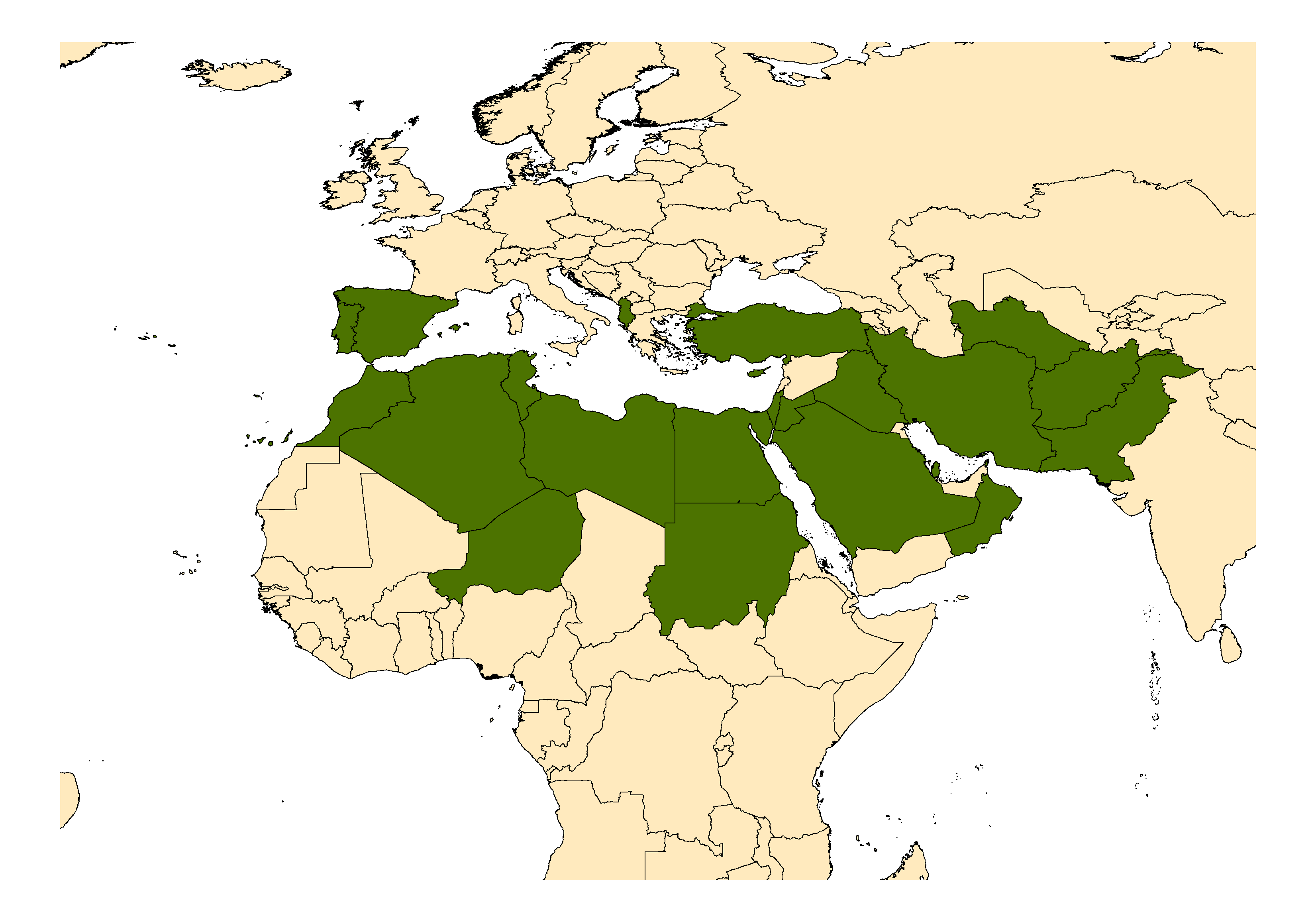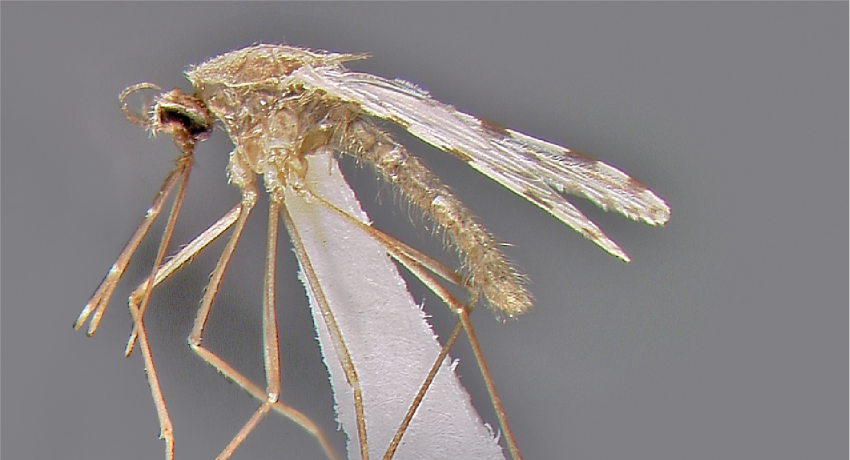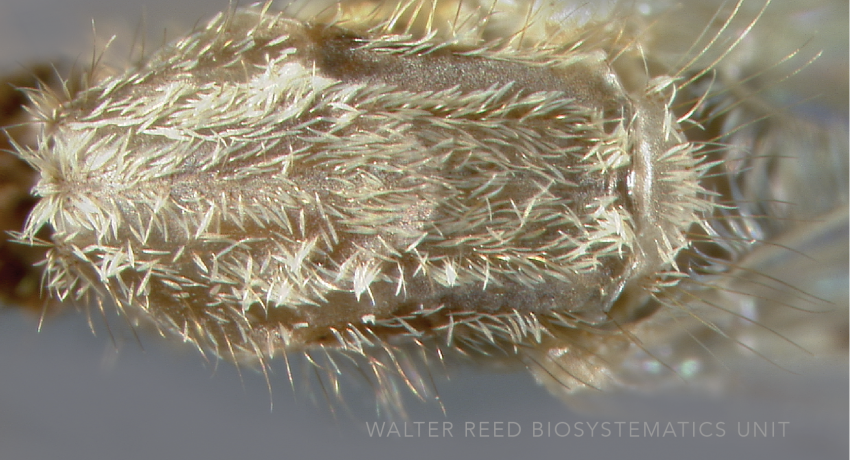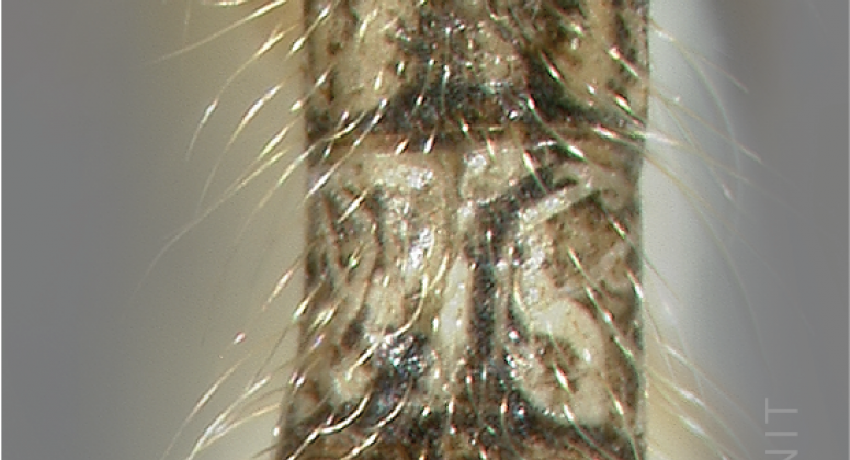PALEARCTIC, AFROTROPICAL & NEAREASTERN REGIONS
Etymology: many colors (L)
Anopheles multicolor is a desert species, whose range extends from North Africa (including the Canary Islands), through the eastern Mediterranean basin and Cyprus into southwest Asia to Pakistan. It is a pale species, with light-colored scales on the scutum and head vertex, and the wings have a distinctive broad pale spot at the base of the costa. The palps of An. multicolor display three distinct pale bands with the terminal palpal segment (MPlp5) entirely dark. Together with An. listeri De Meillon, and An. seretsei Abdulla-Khan, Coetzee & Hunt, An. multicolor comprises the Listeri Group of the Paramyzomyia Series. Three synonyms exist: chaudoyei Theobald (Algeria), impunctus Dönitz (Egypt), and nigrifasciatus Theobald (Pakistan). There is no evidence to suggest that An. multicolor comprises a species complex.
Type locality: Isthme de Suez, Egypt
Type depository: Faculte de Medicine, University of Paris, Paris, France [Laboratoire de Parasitologie et Mycologie] (FMP)
DIAGNOSTIC CHARACTERS (Click photos to view; mouse over and click large photo to zoom in.)
ADULT (illustrated): Head: Erect head scales broad, white on vertex, dark brown posteriorly and laterally; palpus with 3 distinct pale bands; MPlp5 dark apically. Thorax: Scutum with numerous pale scales and setae; scutal fossa with scattered pale scales. Wing: Costa with at least four separate dark areas; base of costa with broad pale spot (basal pale + prehumeral pale, basal dark missing).
LARVA (not illustrated): Head: Setae 2,3-C single; seta 2-C distinctly longer than seta 4-C; setae 5–7-C long, plumose. Thorax: Seta 1-P with very small unsclerotized base; one of setae 9–12-M single; setae 1-T rudimentary, not palmate. Abdominal segments: Tergum without posterolateral scale tufts; tergal plates narrower than distance between palmate setae.
TAXONOMIC KEYS
Pringle et al. 1960
Glick 1992
Becker et al. 2010
![]()
WRBU - Anopheles - Afrotropical Region - Larva
![]()
WRBU - Anopheles - Western Palearctic Region - Adult
![]()
WRBU - Genera - Global - Adult
![]()
WRBU - Genera - Global - Larva
![]()
WRBU - Genera - Afrotropical - Adult
![]()
WRBU - Genera - Afrotropical - Larva
![]()
WRBU - Genera - Eastern Palearctic - Adult
![]()
WRBU - Genera - Eastern Palearctic - Larva
Exemplar DNA sequences
An. multicolor ITS2: AY564228-29; VGSC gene intron: AY902754
BIONOMICS
Immatures
Although An. multicolor immatures have been collected in fresh water oases, the species appears to prefer brackish water collections in cesspools, old shallow wells, stagnant and flowing drains, and ground pools, with or without vegetation. They have even been recovered from small water collections in salt pans at almost 6% salinity. In northern Africa, larval densities of An. multicolor peak between April and July, and again in November to December.
Adults
Anopheles multicolor are found in inland or coastal sites in semi-arid or desert regions. Anopheles multicolor is a major malaria vector in Egypt, where it readily enters houses to feed on man. However, other populations are considered primarily exophilic, and of little biomedical importance, even at high densities. Adult An. multicolor are strong flyers and host-seeking females have been collected up to 13km from suitable immature habitats.
DISTRIBUTION NOTES
Afghanistan, Albania, Algeria, Cyprus, Egypt, Iran, Iraq, Israel (and Gaza Strip & West Bank), Jordan, Libya, Morocco, Niger, Oman, Pakistan, Portugal, Qatar, Saudi Arabia, Spain (includes Canary Islands), Sudan, Tunisia, Turkey, Turkmenistan.

WRBU VECTOR HAZARD REPORTS
None; View other WRBU Vector Hazard Reports
Available GIS Models:
IMPORTANT REFERENCES (full citations below)
Cambouliu 1902: 705 (F)
Séguy 1924: 157 (E*), 159 (L*), as chaudoyei
Christophers 1933: 257 (M*, F*, P, L*, E)
Evans 1938: 343 (M*, F*, P, L*, E)
Ross & Roberts 1943b: 25 (M*, F*, L*; taxonomy, distribution, bionomics)
De Meillon 1947b: 219 (M*, F*, L*, E*)
Senevet et al. 1956 (L*; taxonomy)
Pringle et al. 1960 (L*; key, bionomics)
Gillies & De Meillon 1968: 316 (distribution)
Mattingly 1969c (E*)
Aslamkhan 1971b (distribution; Pakistan)
Glick 1992 (F*; key, taxonomy, distribution)
Abdullah & Merdan 1995 (distribution; Saudi Arabia)
Amr et al. 1997 (distribution; Jordan)
Eritja et al. 2000 8: 11 (distribution; Spain)
Hadjivassilis 2000 7: 38 (distribution)
Trari et al. 2002: 331 (distribution; Morocco)
Becker et al. 2010: 182 (M*, F*, L*; keys, taxonomy, distribution, bionomics)
Ahmed et al. 2011 (distribution; Saudi Arabia)
Kyalo et al. 2017 (distribution; sub-Saharan Africa)
Robert et al. 2019 (distribution; western Palearctic)
CURRENT SYNONYMS
syn. impunctus Dönitz
1902: 67 (A). Type locality: Wadi [el] Natrun [south of Alexandria], Egypt (NE).
syn. chaudoyei Theobald
1903a: 68 (M*, F*; Pyretophorus). Type locality: Touggourt, Algeria (NHMUK).
syn. nigrifasciatus Theobald
1907: 65 (F; Pyretophorus). Type locality: Peshin [Baluchistan, Pakistan] (NHMUK).
CURRENT SUBSPECIES
None
CITED REFERENCES
Abdullah, M.A.R., & Merdan, A.I. (1995). Distribution and ecology of the mosquito fauna in the southwestern Saudi Arabia. Journal of the Egyptian Society of Parasitology, 25(3), 815–837.
Ahmed, A.M., Shaalan, E.A., Aboul-Soud, M.A.M., Tripet, F., & Al-Khedhairy, A.A. (2011). Mosquito vectors survey in the Al-Ahsaa district of eastern Saudi Arabia. Journal of Insect Science, 11, 176.
Amr, Z.S., Al-Khalili, Y.H., & Arbaji, A. (1997). Larval mosquitoes collected from northern Jordan and the Jordan Valley. Journal of the American Mosquito Control Association, 13(4), 375–378.
Aslamkhan, M. (1971b). The mosquitoes of Pakistan I. A checklist. Mosquito Systematics, 3(4), 147–159.
Becker, N., Petrić, D., Zgomba, M., Boase, C., Madon, M., Dahl, C., & Kaiser, A. (2010). Mosquitoes and their control (Second ed.). Berlin Heidelberg: Springer-Verlag.
Cambouliu, M. (1902). Contribution a l'étude des Anopheles de l'isthme de Suez. Comptes Rendus de l'Académie des Sciences, 135, 704–706.
Christophers, S.R. (1933). The fauna of British India, including Ceylon and Burma. Diptera.Vol. IV. Family Culicidae. Tribe Anophelini. London: Taylor and Francis.
De Meillon, B. (1947b). The Anophelini of the Ethiopian geographical region. Publications of the South African Institute for Medical Research, 10(49), 1–272.
Dönitz, W. (1902). Beitrage zur Kenntniss der Anopheles. Zeitschrift fur Hygiene, 41, 15–88.
Eritja, R., Aranda, C., Padrós, J., Goula, M., Lucientes, J., Escosa, R., . . . Cáceres, F. (2000). An annotated checklist and bibliography of the mosquitoes of Spain (Diptera: Culicidae). European Mosquito Bulletin, 8, 10–18.
Evans, A.M. (1938). Mosquitoes of the Ethiopian Region. II. Anophelini adults and early stages. London: British Museum (Natural History).
Gillies, M.T., & de Meillon, B. (1968). The Anophelinae of Africa, south of the Sahara (Ethiopian zoogeographical region). Publications of the South African Institute for Medical Research, 54, 1–343.
Glick, J.I. (1992). Illustrated key to the female Anopheles of southwestern Asia and Egypt (Diptera: Culicidae). Mosquito Systematics, 24(2), 125–153.
Hadjivassilis, A. (2000). Mosquitoes (Diptera: Culicidae) of Cyprus. European Mosquito Bulletin, 7, 38.
Kyalo, D., Amratia, P., Mundia, C.W., Mbogo, C.M., Coetzee, M., & Snow, R.W. (2017). A geo-coded inventory of anophelines in the Afrotropical Region south of the Sahara: 1898–2016. Wellcome Open Research, 2, 57.
Mattingly, P.F. (1969c). Mosquito eggs II. III. Tribe Anophelini. Mosquito Systematics Newsletter 1(3), 41–50.
Pringle, C.A.T., Azzawi, M., Riyadh, H., & Murayati, Y. (1960). The anopheline larvae of Iraq with a Report on A. culicifacies, A. multicolor and A. apoci breeding in Syrian desert spring. Bulletin of Endemic Diseases (Baghdad), 3, 36–56.
Robert, V., Günay, F., Le Goff, G., Boussès, P., Sulesco, T., Khalin, A., Medlock, J.M., Kampen, H., Petrić, D. & F. Schaffner. (2019). Distribution chart for Euro-Mediterranean mosquitoes (western Palaearctic region). Journal of the European Mosquito Control Association, 37, 1–28.
Ross, E.S., & Roberts, H.R. (1943b). Mosquito atlas. Part II. Eighteen old world anophelines important to malaria. Contributions of the American Entomological Institute.
Séguy, E. (1924). Les moustiques de l'Afrique Mineure, de l'Egypte et de la Syrie. Encyclopedie Entomologique (A), 1, 1–257.
Senevet, G., Andarelli, L., & Duzer, A. (1956). Études sur les stations a Anopheles multicolor des environs de Tenes (Algérie). Archives de l'Institut Pasteur d'Algérie, 34(1), 119–128.
Theobald, F.V. (1903a). A monograph of the Culicidae of the World (Vol. 3). London: British Museum (Natural History). 359pp
Theobald, F.V. (1907). A monograph of the Culicidae of the world (Vol. IV). London: British Museum (Natural History). 359pp
Trari, B., Dakki, M., Himmi, O., & El Agbani, M.A. (2002). Le moustiques (Diptera: Culicidae) du Maroc: Revue bibliographique (1916–2001) et inventaire des espèces. Bulletin de la Société de pathologie exotique (Paris), 96(4), 329–334.
CITE THIS PAGE
Walter Reed Biosystematics Unit (Year). Anopheles multicolor species page. Walter Reed Biosystematics Unit Website, http://wrbu.si.edu/vectorspecies/mosquitoes/multicolor, accessed on [date (e.g. 03 February 2020) when you last viewed the site].











































































































































































